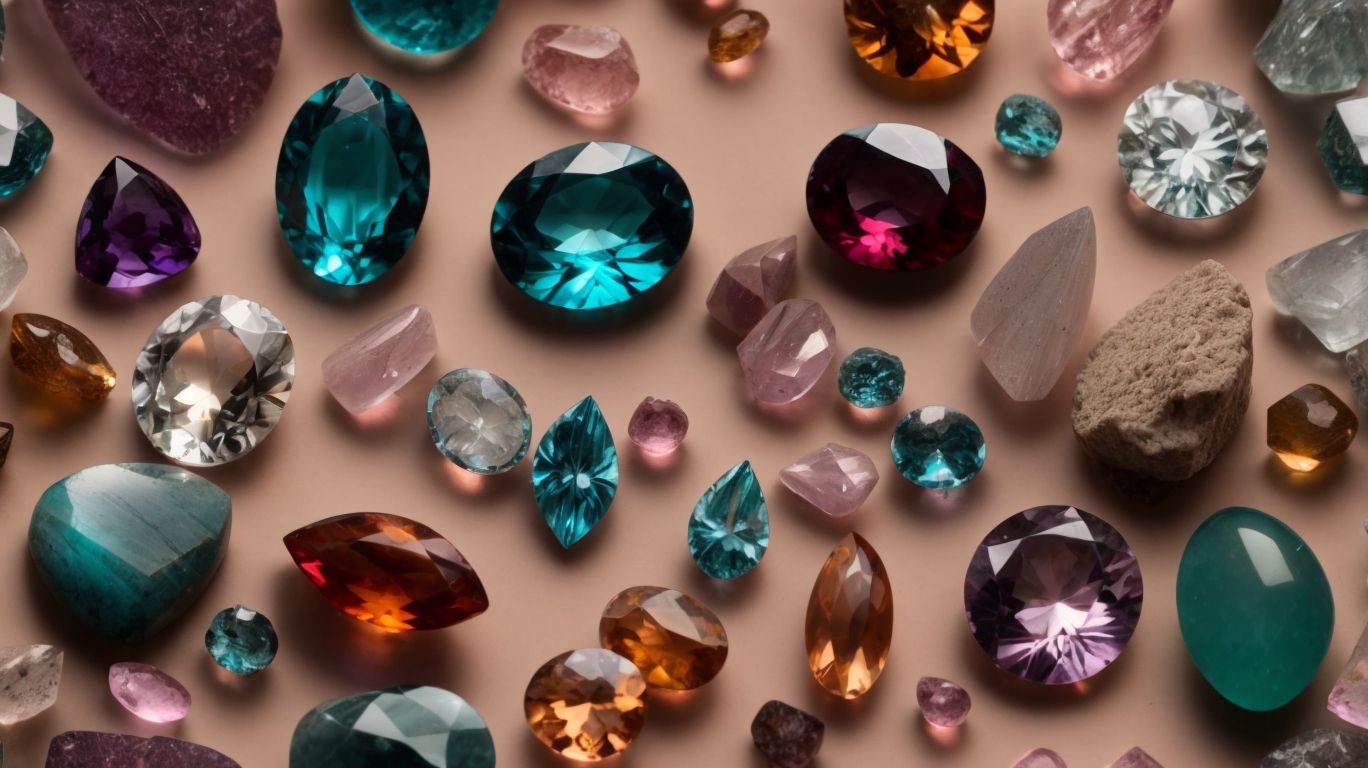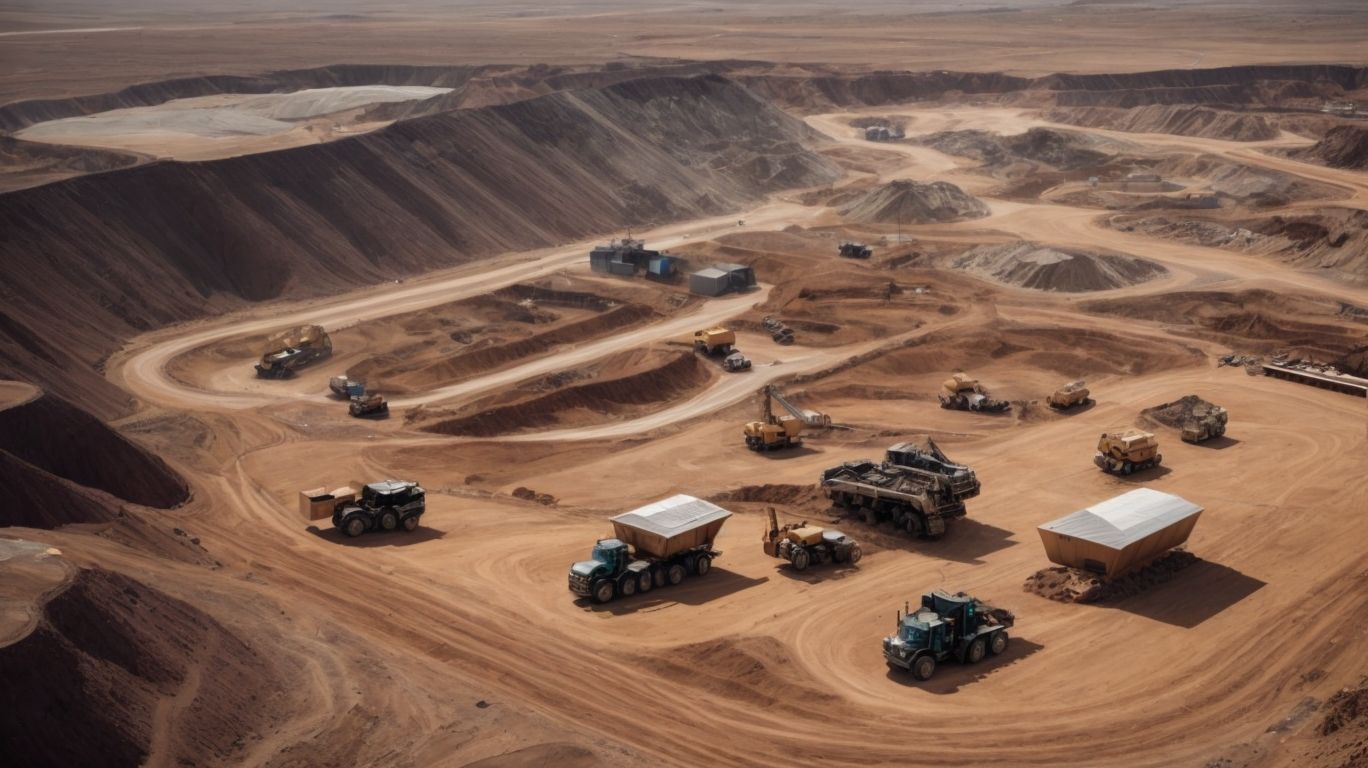
From the Earth to Elegance: The Gemstone Formation Process
Gemstones, beautiful and captivating, have intrigued humans for centuries with their radiant colors and sparkling allure.
Let’s explore the fascinating world of gemstones, from their formation deep within the Earth to their exquisite beauty when cut and polished.
Discover the different types of gemstones, the mining process, and the various factors that determine their value.
Uncover the secrets behind these stunning creations of nature.
What Are Gemstones?
Gemstones are exquisite minerals that derive their elegance from the Earth’s geological processes, encompassing a diverse range of precious stones highly prized by gemologists and mineralogy enthusiasts.
Their formation typically occurs deep within the earth’s crust under intense pressure and heat, resulting in the creation of stunning formations like diamonds, rubies, sapphires, and emeralds.
These natural marvels captivate experts with their unique colors, clarity, and durability, making them ideal for jewelry and ornamental purposes. Gemstones are also fascinating for lapidary specialists who study and shape these precious materials into exquisite faceted gems that showcase their brilliance and aesthetics to perfection.
How Are Gemstones Formed?
The formation of gemstones is a fascinating process involving crystallization within geological environments, where minerals undergo intricate stages to develop distinct crystal structures and create gemstone deposits.
Initially, gemstones begin their journey deep within the Earth’s mantle, where intense heat and pressure cause minerals to crystallize and form unique structures. Over time, as geological processes bring these formations closer to the surface, factors like temperature gradients and chemical compositions further influence the growth of these crystalline structures.
This gradual process, often taking millions of years, results in the formation of precious gemstones such as diamonds, rubies, and sapphires, each with its own distinctive characteristics and beauty.
Igneous Processes
Igneous processes play a crucial role in the formation of gemstones over vast geological time scales, influencing their quality, color variations, chemical compositions, and unique origins.
These processes involve the cooling and solidification of molten rock, leading to the formation of gem-bearing minerals such as quartz, topaz, and tourmaline. The rate at which the magma cools affects the crystal growth within the rock, influencing the clarity and size of gemstones. The presence of specific chemical elements in the magma can produce vibrant colors in gemstones, making them highly sought after in the jewelry industry.
Gemstone miners often trace the origins of these precious minerals back to volcanic activities and deep-seated igneous intrusions, highlighting the intricate connection between the Earth’s processes and the creation of these valuable treasures.
Metamorphic Processes
Metamorphic processes are vital in shaping gemstone clarity, revealing unique inclusions, and providing opportunities for enhancements that enhance the beauty and allure of gemstones.
These processes involve the transformation of minerals under intense heat and pressure deep within the Earth’s crust, altering the structure and composition of gemstones. As these changes occur, existing inclusions may be reorganized or redistributed, affecting the overall clarity of the gemstone.
Metamorphic transformations can create new opportunities for enhancing the gemstone’s appearance through treatments like heat treatment or irradiation, adding significant value to the final product. The interplay between metamorphic processes and gemstone characteristics is a fascinating aspect of the gemstone industry, offering a diverse range of possibilities for creating exquisite and unique pieces.
Sedimentary Processes
Sedimentary processes contribute to the formation of gemstones with unique characteristics, influencing their cut, rarity, and requiring specialized mining techniques to extract these precious minerals.
These processes involve the deposition and compaction of mineral-rich sediments over millions of years, leading to the creation of gemstones like diamonds, opals, and sapphires. The pressure and heat during this geological transformation play a crucial role in determining the clarity and color intensity of the gemstones.
The specific sedimentary environments where these minerals are formed greatly impact their overall quality and value in the market. To access these gemstone deposits, miners often have to employ intricate extraction methods tailored for sedimentary formations, ensuring the careful retrieval of these precious stones.
What Factors Affect the Formation of Gemstones?
Several factors influence the formation of gemstones, including temperature, pressure, chemical compositions, and the element of time, which collectively shape the unique characteristics of each gemstone.
Temperature plays a crucial role in determining the color and clarity of gemstones, with higher temperatures often resulting in more vibrant hues. Pressure affects the density and structure of gemstones, influencing their durability and susceptibility to fractures. The chemical composition of the surrounding environment during formation determines the presence of trace elements, which give gemstones their distinctive colors. Over time, geological processes consolidate these factors, leading to the creation of precious gemstones with their individual properties and allure.
Precious Gemstones
Precious gemstones hold significant value in the gemstone market, where their rarity, quality, and unique properties determine their appraisal and grading standards.
- These exquisite gems are sought after by collectors and enthusiasts for their beauty and investment potential.
- The market value of gemstones is influenced by various factors such as color, clarity, cut, and carat weight.
- Gemstones like diamonds, rubies, sapphires, and emeralds are among the most valuable and highly prized in the industry.
Gemstone grading involves assessing these characteristics to determine the overall quality and worth of each stone, with certifications from reputable laboratories adding credibility to their market value.
Semi-Precious Gemstones
Semi-precious gemstones offer a diverse range of varieties, requiring proper cleaning and care to maintain their luster and beauty over time.
Each type of semi-precious gemstone, such as amethyst, citrine, or turquoise, possesses unique characteristics that make them popular choices for jewelry and accessories. Amethyst, known for its stunning purple hue, symbolizes clarity and tranquility, while citrine, with its warm yellow tones, represents prosperity and success. Turquoise, a timeless favorite, evokes a sense of protection and healing.
To ensure these gems retain their vibrancy, it’s essential to clean them regularly with a soft cloth and mild soap, avoiding harsh chemicals and extreme temperatures that can damage the stones.
Organic Gemstones
Organic gemstones, formed from natural materials, require special preservation techniques to withstand the test of time and remain relevant in the ever-evolving landscape of gemstone fashion.
These unique gems, derived from living organisms, such as pearls, amber, and coral, possess a distinct charm and beauty that captivates jewelry enthusiasts worldwide. To ensure their longevity, it is essential to store organic gemstones away from direct sunlight and chemicals that can damage their natural luster. Regular cleaning with a soft cloth and mild soapy water can help maintain their brilliance. By embracing sustainable practices and proper care routines, individuals can contribute to the preservation of these exquisite treasures for generations to come.
How Are Gemstones Mined?
Gemstones are extracted through various mining methods, including open-pit mining, underground mining, and alluvial mining, followed by meticulous gem cutting to enhance their beauty.
- Open-pit mining involves removing surface layers to access gemstone deposits.
- Underground mining requires tunnels to reach deeper gemstone sources.
- In alluvial mining, gemstones are recovered from sediment deposits in riverbeds and coastal areas.
Post-extraction, gemstones undergo processes like faceting, polishing, and shaping to reveal their brilliance and color. Lapidaries use equipment like saws, grinders, and polishing wheels to cut and enhance gemstones, followed by precision cutting to create facets that reflect light and bring out the gem’s natural characteristics.
Open-pit Mining
Open-pit mining is a common method employed to extract gemstones from the Earth, allowing access to valuable deposits that may vary in rarity and quality.
By utilizing open-pit mining, miners can efficiently reach gemstone reserves buried beneath the Earth’s surface, unveiling gems of exquisite brilliance that might otherwise remain undiscovered. This method offers a cost-effective approach to uncovering gemstone treasures, especially those of high commercial value.
The process involves the removal of soil and rock layers to expose gem-bearing ore, enabling the extraction of precious stones such as diamonds, emeralds, and rubies. This method of mining plays a crucial role in meeting the demand for gemstones of varying scarcities, ensuring a sustainable supply for the jewelry industry.
Underground Mining
Underground mining serves as a method to extract gemstones from beneath the Earth’s surface, revealing valuable treasures that hold significant value and rarity in the gemstone market.
Taking place deep within the earth, this process involves skilled miners utilizing specialized equipment to access gemstone deposits hidden from plain sight.
These gems, once unearthed, undergo meticulous appraisal to determine their quality and worth in the industry. The scarcity of these gems adds to their allure, with certain varieties fetching exceptionally high prices due to their limited availability.
Through the precision and expertise of underground mining, exquisite gemstones coveted by collectors and enthusiasts alike are meticulously extracted and brought to light.
Alluvial Mining
Alluvial mining involves extracting gemstones from riverbeds and sediment deposits, contributing to the market supply and influencing current trends in the gemstone industry.
This method of mining, which relies on natural erosion processes to reveal gems hidden beneath the Earth’s surface, plays a significant role in the gemstone market dynamics. As these gems are sourced from riverbeds and alluvial deposits, their unique characteristics and quality often set trends within the industry, shaping consumer preferences and influencing the overall market value of specific gemstones. By tapping into these natural sources, miners can uncover a diverse range of gemstones, adding variety and exclusivity to the market.
How Are Gemstones Cut and Polished?
Gemstones undergo precision cutting and polishing techniques, such as faceting, to enhance their inherent characteristics and reveal their full beauty and brilliance.
- During the faceting process, each gemstone is carefully examined to determine the optimal angles for cutting based on its unique attributes like color, clarity, and refractive index.
- Skilled gem cutters use various tools, such as a rotating lapidary machine with diamond-tipped saws and polishing wheels, to create symmetrical facets that reflect and refract light in a way that highlights the gem’s natural radiance.
- This meticulous process requires expertise and artistry to bring out the best in each gemstone, resulting in stunning pieces of jewelry that captivate and mesmerize observers.
What Are the Uses of Gemstones?
Gemstones serve diverse purposes, from adorning exquisite jewelry pieces to finding applications in industrial settings and playing pivotal roles in spiritual and healing practices.
From ancient times, gemstones have dazzled with their vibrant colors and innate beauty, captivating humanity across various cultures. In jewelry design, these precious stones are meticulously cut and set to enhance their brilliance and allure.
Beyond aesthetics, gemstones are also utilized in various industries, such as technology and manufacturing, due to their hardness and durability. In spiritual realms, gemstones are believed to harness specific energies and provide healing properties, with each stone attributed with distinct characteristics and abilities.
Jewelry
Gemstones are integral to the world of jewelry, lending their unique colors, cuts, and properties to exquisite designs that resonate with fashion trends and personal styles.
These precious stones play a pivotal role in shaping the landscape of jewelry, influencing design aesthetics and capturing the imagination of jewelry enthusiasts. From the vibrant hues of emeralds to the timeless elegance of diamonds, each gemstone brings its own allure to the crafted pieces.
The artistry involved in creating gemstone jewelry involves a delicate balance of technical expertise and creative vision, resulting in stunning and wearable masterpieces that make a statement. Gemstones are not just accessories but symbols of individuality and sophisticated taste, adding a touch of luxury and personality to any outfit.
Industrial Applications
Gemstones find practical applications in various industries, where their unique properties and durability contribute to technological advancements and value-added products.
Their hardness and resistance to heat make them ideal for cutting tools used in industries like manufacturing and construction. Gemstones such as diamonds are crucial in precision machining due to their ability to grind and polish with remarkable efficiency. The optical properties of gemstones also play a critical role in lasers, telecommunications, and medical devices, where they are employed for their high refractive index and light-transmitting characteristics.
Spiritual and Healing Practices
Gemstones hold symbolic significance in spiritual practices and are believed to possess healing properties, with each gemstone harnessing unique energies that influence well-being.
These metaphysical properties are thought to interact with the body’s energy centers, promoting balance and harmony.
For example, amethyst is often used to enhance intuition and provide a sense of calmness, while rose quartz is associated with love and emotional healing.
Many individuals use gemstones during meditation or wear them as jewelry to benefit from their energetic influence.
The holistic approach to gemstone healing integrates these beliefs into daily rituals, aligning mind, body, and spirit for overall wellness.
What Are the Factors That Determine the Value of a Gemstone?
The value of a gemstone is determined by several key factors, including its rarity, color intensity, clarity levels, precise cut and shape, and the weight measured in carats.
Each of these factors plays a crucial role in assessing the quality and desirability of a gemstone. Rarity, for instance, greatly enhances the worth of a gem, as it indicates exclusivity and limited availability. Vibrant color intensity adds allure and character to a gem, influencing its visual appeal and market demand. Clarity, referring to the absence of inclusions or imperfections, affects the stone’s brilliance and transparency. A precise cut can maximize a gem’s brilliance and sparkle, making it more valuable. The weight of a gemstone, measured in carats, directly impacts its price, with larger stones often commanding higher values.
Rarity
The rarity of a gemstone plays a pivotal role in elevating its value and desirability among collectors and enthusiasts, reflecting the scarcity and uniqueness of the gem.
When a gemstone is uncommon or difficult to source, it automatically becomes more exclusive and sought after in the market. The limited availability of certain gemstones adds a sense of prestige and allure, driving up their market worth. Gemstones that are rare tend to command higher prices due to the innate human inclination towards owning something distinctive and valuable. This rarity factor is a key element that contributes to the fascination and value placed on gemstones by those who appreciate their beauty and rarity in equal measure.
Color
Color is a defining characteristic of gemstones, with vibrant hues and distinct color saturations influencing the aesthetic appeal and intrinsic properties of each gemstone.
The color of a gemstone not only adds to its physical beauty but also serves as a key determinant of its value and desirability. For instance, the deep red hue of a ruby symbolizes passion and vitality, while the calming blue of a sapphire signifies wisdom and royalty.
The intensity of color saturation can impact the gemstone’s durability and brilliance, with vivid colors often indicating a higher quality gem. Gemstone enthusiasts often appreciate the variety of colors available, ranging from the fiery orange of a spessartite garnet to the serene green of an emerald, each offering a unique visual experience.
Clarity
Clarity is a critical factor in evaluating gemstones, with the presence of inclusions or imperfections affecting the transparency, brilliance, and overall quality of the gem.
Gemstone clarity serves as a key determinant in the grading process, significantly influencing the value and visual appeal of the gem. Inclusions, which are internal characteristics, and imperfections, external blemishes, play a vital role in determining the transparency of the gemstone. Gemologists assess clarity using standardized grading systems like the GIA clarity scale, which categorizes stones based on the visibility and impact of inclusions.
Customers seeking high-quality gemstones should prioritize clarity, as it directly correlates with the gem’s beauty and durability.
Cut and Shape
The cut and shape of a gemstone significantly influence its brilliance, fire, and overall appeal, with well-crafted cuts enhancing the gem’s rarity and unique characteristics.
By using precise cutting techniques, gem cutters are able to maximize the play of light within a gemstone, unveiling its inner beauty in ways that captivate the beholder. The interplay between a gemstone’s natural characteristics such as color, clarity, and carat weight, and the specific cutting styles chosen can result in a masterpiece that stands out for its brilliance and rarity in the world of gemstones. Each faceted angle or sculpted contour meticulously crafted into the gemstone contributes to its overall visual impact and desirability.”
Carat Weight
Carat weight is a fundamental metric in assessing the value and rarity of gemstones, with larger carat weights often correlating with increased desirability and market worth.
The carat weight of a gemstone plays a crucial role in determining its overall value. Gemstones with higher carat weights are perceived as more valuable due to their rarity and perceived scarcity in the market.
When it comes to gemstone valuation, the carat weight is often a key factor that collectors and buyers consider. The market dynamics related to carat sizes can significantly impact pricing, with larger carat gemstones fetching higher prices in auctions and sales.
Gemstone weight assessments are conducted meticulously to ensure accurate valuation and fair pricing in the market.
What Are the Different Types of Gemstones?
Gemstones come in various types and varieties, each possessing unique characteristics that influence their rarity, market demand, and distinctive features.
For instance, precious gemstones like diamonds, rubies, and sapphires are highly sought after due to their scarcity in nature and enduring value. On the other hand, semi-precious gemstones such as amethyst, citrine, and turquoise, while more abundant, still exhibit stunning colors and metaphysical properties that appeal to a wide range of consumers. The market presence of certain gemstones can also fluctuate based on trends and cultural preferences, reshaping the dynamics of the gemstone industry and driving interest in specific varieties.
Precious Gemstones
Precious gemstones are renowned for their rarity, exceptional quality, and adherence to stringent grading standards that enhance their market value and desirability.
Gemstone grading is a meticulous process that evaluates various factors such as color, clarity, cut, and carat weight to determine its overall quality. The Gemological Institute of America (GIA) and other reputable gem labs establish strict criteria for assessing the value and authenticity of gemstones, ensuring consumers receive genuine, high-quality stones. These grading standards play a crucial role in distinguishing between ordinary gemstones and truly exceptional ones, elevating the allure and prestige of these coveted treasures in the world of jewelry and collectors alike.
Semi-Precious Gemstones
Semi-precious gemstones offer versatility in applications, requiring proper care, cleaning, and preservation to maintain their longevity and appeal in diverse settings.
These gemstones, including amethyst, citrine, and turquoise, are commonly used in jewelry and decorative pieces due to their vibrant colors and affordable pricing.
To ensure these stones retain their beauty, it is essential to store them in a separate compartment to prevent scratches and impacts. Regularly cleaning them with a soft cloth and mild soap helps in removing dirt and oils that can affect their shine. Avoiding direct exposure to harsh chemicals and extreme temperatures is crucial for preserving their luster and quality over time.
Organic Gemstones
Organic gemstones, sourced from natural materials, hold cultural significance and aesthetic appeal, often requiring specific preservation methods to retain their unique beauty and historical importance.
These gemstones, such as pearls, amber, and coral, have been treasured for centuries for their luxurious allure and symbolic meanings across various cultures.
Pearls, known as the ‘queen of gems,’ symbolize purity and wisdom, while amber is believed to have healing properties.
Coral, associated with protection and prosperity, has adorned jewelry pieces as a symbol of good luck.
Embracing organic gemstones in contemporary fashion trends not only adds a touch of timeless elegance but also connects wearers to the rich traditions and stories embedded in these precious creations.




No Comments